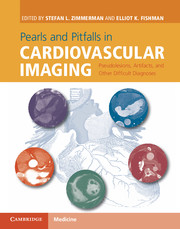 Pearls and Pitfalls in Cardiovascular Imaging
Pearls and Pitfalls in Cardiovascular Imaging from Section 4 - Coronary arteries
Published online by Cambridge University Press: 05 June 2015
Imaging description
Caseous, or liquefactive, calcification of the mitral annulus is a rare variant of mitral annular calcification. In caseous mitral annular calcification, a smooth, ovoid mass is found within the mitral annulus with rim calcification and a homogenous, moderately hyperattenuating center on computed tomography (CT) (Figure 39.1). The liquefactive center of the lesion is not as densely hyperattenuating as vascular or osseous calcifications. In some cases, the center of the lesion may contain low- attenuation components (Figure 39.2). These masses are commonly located in the inferior or lateral aspect of the left atrioventricular groove and may displace mitral valve leaflets from mass effect. In some cases, multiple masses or continuous calcification around the entire mitral valve annulus may be seen (Figure 39.3). Caseous calcification may be initially discovered at echocardiography, where they appear as a rounded echogenic mass with central hypoechogenicity due to a central core of liquefactive necrosis. At pathology, the center of these lesions is composed of a toothpaste-like material that represents a mix of calcium, fatty acids, and cholesterol.
Importance
Rounded masses of caseous mitral annular calcification can be incorrectly diagnosed as circumflex coronary artery aneurysms, given their similar location and attenuation on contrast-enhanced CT (Figure 39.1). This could lead to additional inappropriate diagnostic tests, such as cardiac catheterization, or surgery. Caseous mitral calcification is a benign condition; however, rare complications due to ulceration resulting in distal embolization and/or endocarditis have been reported. Caseous calcifications may also be associated with mitral valve stenosis or regurgitation due to mass effect.
Typical clinical scenario
Caseous mitral annular calcification is an uncommon condition, with a prevalence of < 0.1% in large echocardiographic studies. Among patients with mitral annular calcification, caseous degeneration is reported in < 1% of cases. Caseous mitral calcification is typically an incidental finding on CT, MR, or echocardiographic exams performed for other reasons. Occasionally, patients may be referred to cardiac CT or MRI for definitive evaluation if the diagnosis is unclear on echocardiography.
To save this book to your Kindle, first ensure no-reply@cambridge.org is added to your Approved Personal Document E-mail List under your Personal Document Settings on the Manage Your Content and Devices page of your Amazon account. Then enter the ‘name’ part of your Kindle email address below. Find out more about saving to your Kindle.
Note you can select to save to either the @free.kindle.com or @kindle.com variations. ‘@free.kindle.com’ emails are free but can only be saved to your device when it is connected to wi-fi. ‘@kindle.com’ emails can be delivered even when you are not connected to wi-fi, but note that service fees apply.
Find out more about the Kindle Personal Document Service.
To save content items to your account, please confirm that you agree to abide by our usage policies. If this is the first time you use this feature, you will be asked to authorise Cambridge Core to connect with your account. Find out more about saving content to Dropbox.
To save content items to your account, please confirm that you agree to abide by our usage policies. If this is the first time you use this feature, you will be asked to authorise Cambridge Core to connect with your account. Find out more about saving content to Google Drive.